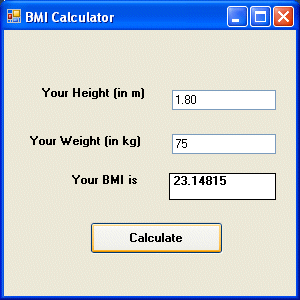VB2010 Lesson 7- Mathematical Operations
|
Computer can perform
mathematical calculations much faster than human beings. However,
computer itself will not be able to perform any mathematical
calculations without receiving instructions from the user. In
VB2010, we can write code to instruct the computer to perform
mathematical calculations such as addition, subtraction,
multiplication, division and other kinds of arithmetic operations.
In order for VB2010 to carry out arithmetic calculations, we need to
write code that involve the use of various arithmetic operators. The
VB2010 arithmetic operators are very similar to the normal
arithmetic operators, only with slight variations. The plus and
minus operators are the same while the multiplication operator use
the * symbol and the division operator use the / symbol. The list of
VB2010 arithmetic operators are shown in table 7.1
below:
sTable 7.1: Arithmetic
Operators Operator Mathematical
function Example + -- ^ Exponential 2^4=16 * Multiplication 4*3=12,
(5*6))2=60 / Division 12/4=3 Mod Modulus (return the
remainder from an integer division) 15 Mod
4=3 255 mod
10=5 \ Integer Division
(discards the decimal places) 19\4=4 Example 7.1 In this program, you need to insert two Textboxes, four labels and one button. Click the button and key in the code as shown below. Note how the various arithmetic operators are being used. When you run the program, it will perform the four basic arithmetic operations and display the results on the four labels.
Example 7.2 The program can use Pythagoras Theorem to calculate the length of hypotenuse c given the length of the adjacent side a and the opposite side b. In case you have forgotten the formula for the Pythagoras Theorem, it is written as
Example 7.3: BMI Calculator A lot of people are obese now and it could affect their health seriously . Obesity has proven by the medical experts to be a one of the main factors that brings many adverse medical problems, including the the heart disease. If your BMI is more than 30, you are considered obese. You can refer to the following range of BMI values for your weight status.
In order to calculate your BMI, you do not have to consult your doctor, you could just use a calculator or a home made computer program, this is exactly what I am showing you here. The BMI calculator is a Visual Basic program that can calculate the body mass index, or BMI of a person based on the body weight in kilogram and the body height in meter. BMI can be calculated using the formula weight/( height )2, where weight is measured in kg and height in meter. If you only know your weight and height in lb and feet, then you need to convert them to the metric system (you could indeed write a VB program for the conversion).
Copyright 2010 Dr.Liew Voon Kiong . All rights reserved |Contact: vbtutor facebook page [Privacy Policy] |
